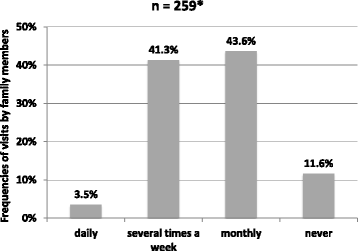Family visits in shared-housing arrangements for residents with dementia--a cross-sectional study on the impact on residents' quality of life
- PMID: 25868401
- PMCID: PMC4347913
- DOI: 10.1186/s12877-015-0012-5
Family visits in shared-housing arrangements for residents with dementia--a cross-sectional study on the impact on residents' quality of life
Abstract
Background: Shared-housing arrangements (SHA) are a German type of small-scale living arrangements for people with dementia (PwD). The involvement of family members is one core domain of SHA. But it has not been investigated yet, what are factors associated with family visits and if family involvement within SHA contributes to better residents' quality of life (QoL).
Method: A cross-sectional study including all SHA in Berlin/Germany was performed. Main parameters of interest were residents' QoL (QUALIDEM) and frequencies of family visits within the SHA. Besides descriptive analyses we used logistic regression and ANCOVA to analyze the data.
Results: 58 SHA with 396 residents (78.4 years, 69.4% female) participated in the study. Older (OR: 1.034; 95% CI: 1.005; 1.064) and female residents (OR: 2.006; 95% CI: 1.018; 3.950) got more often visited by family members. An active participation of family members in SHA contributes on average to a better QoL in terms of social relationship and social isolation (all ANCOVA p < 0.005). A decreased QoL was found for people without family visits compared to those without family members.
Conclusions: The involvement of family members in SHA is common but on a similar level compared to other care arrangements. Staff should convince available family members to visit PwD, in order to improve residents QoL. However, the response rate in the present study was about 13%, which may limit the results.
Similar articles
-
More staff = better quality of life for people with dementia? results of a secondary data analysis in German shared-housing arrangements.Isr J Health Policy Res. 2019 Feb 20;8(1):26. doi: 10.1186/s13584-019-0295-7. Isr J Health Policy Res. 2019. PMID: 30786931 Free PMC article.
-
Health outcomes and quality of life of residents of shared-housing arrangements compared to residents of special care units - results of the Berlin DeWeGE-study.J Clin Nurs. 2012 Nov;21(21-22):3047-60. doi: 10.1111/j.1365-2702.2012.04305.x. J Clin Nurs. 2012. PMID: 23083386
-
Dementia-specific quality of life instruments and their appropriateness in shared-housing arrangements--a literature study.Geriatr Nurs. 2012 May-Jun;33(3):204-16. doi: 10.1016/j.gerinurse.2012.01.001. Epub 2012 Feb 18. Geriatr Nurs. 2012. PMID: 22342922
-
[Shared-housing arrangements for care-dependent people in Germany. A literature overview of structures, outcomes and quality management].Bundesgesundheitsblatt Gesundheitsforschung Gesundheitsschutz. 2013 Oct;56(10):1410-7. doi: 10.1007/s00103-013-1825-z. Bundesgesundheitsblatt Gesundheitsforschung Gesundheitsschutz. 2013. PMID: 23963234 Review. German.
-
Assessment of innovative living and care arrangements for persons with dementia: a systematic review.BMC Geriatr. 2023 Aug 1;23(1):464. doi: 10.1186/s12877-023-04187-4. BMC Geriatr. 2023. PMID: 37525120 Free PMC article.
Cited by
-
Family members' reasoning in relation to pleasant environments in nursing homes.Dementia (London). 2023 Jan;22(1):235-251. doi: 10.1177/14713012221142474. Epub 2022 Nov 25. Dementia (London). 2023. PMID: 36427294 Free PMC article.
-
An overview of innovative living arrangements within long-term care and their characteristics: a scoping review.BMC Geriatr. 2023 Jul 18;23(1):442. doi: 10.1186/s12877-023-04158-9. BMC Geriatr. 2023. PMID: 37464287 Free PMC article.
-
Partnerships in nursing homes: How do family caregivers of residents with dementia perceive collaboration with staff?Dementia (London). 2021 Jul;20(5):1631-1648. doi: 10.1177/1471301220962235. Epub 2020 Sep 25. Dementia (London). 2021. PMID: 32975453 Free PMC article.
-
More staff = better quality of life for people with dementia? results of a secondary data analysis in German shared-housing arrangements.Isr J Health Policy Res. 2019 Feb 20;8(1):26. doi: 10.1186/s13584-019-0295-7. Isr J Health Policy Res. 2019. PMID: 30786931 Free PMC article.
-
Shared Housing Arrangements in Germany-An Equitable Alternative to Long Term Care Services beyond Homes and Institutions?Int J Environ Res Public Health. 2018 Feb 14;15(2):342. doi: 10.3390/ijerph15020342. Int J Environ Res Public Health. 2018. PMID: 29443948 Free PMC article.
References
-
- Wimo A, Prince M. World Alzheimer Report 2010. Alzheimer’s Disease International: The Global Economic Impact of Dementia; 2010.
-
- Moise P, Schwarzinger M, Um M. Dementia care in 9 OECD countries: a comparative analysis. Paris: OECD Publishing; 2004.
Publication types
MeSH terms
LinkOut - more resources
Full Text Sources
Other Literature Sources
Medical


